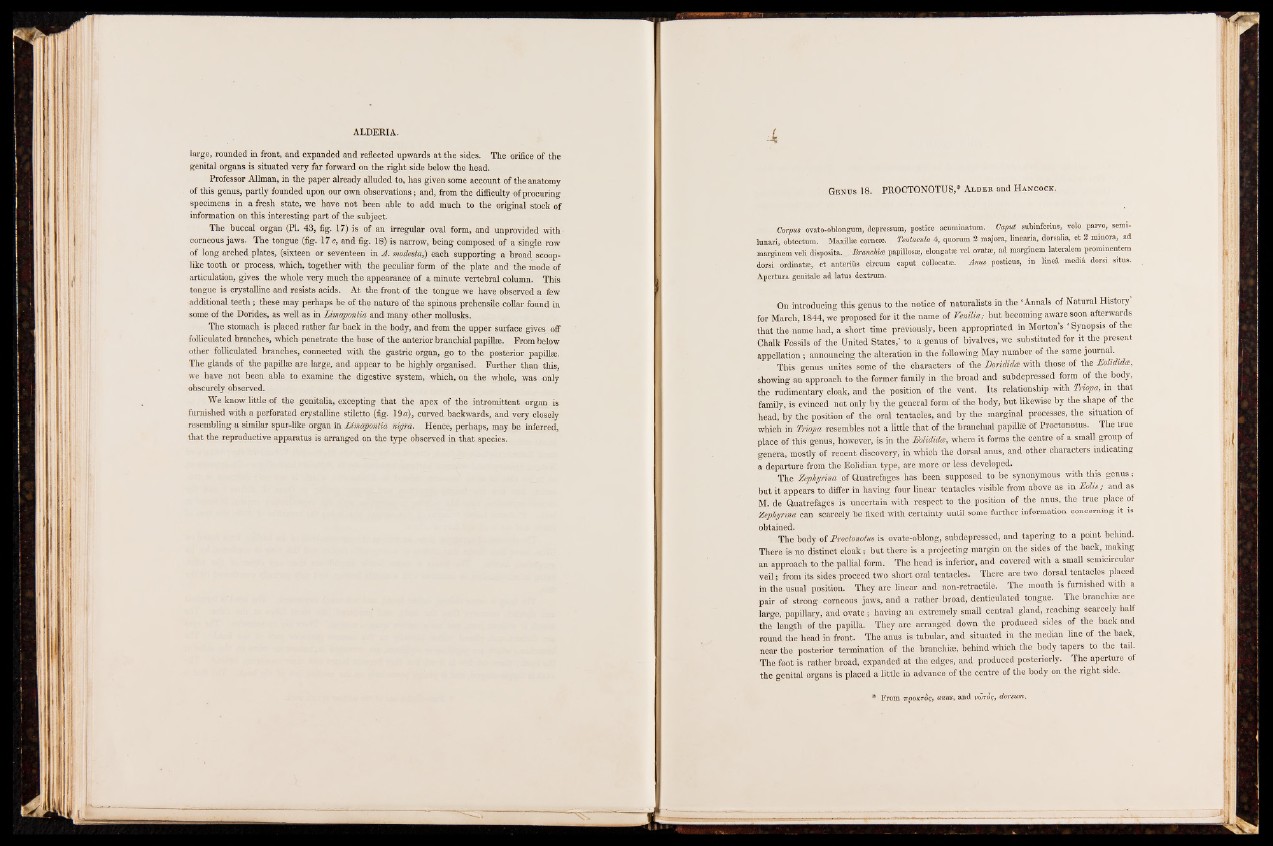
ALDERIA.
large, rounded in front, and expanded and reflected upwards at the sides. The orifice of the
genital organs is situated very far forward on the right side below the head.
Professor Allman, in the paper already alluded to, has given some account of the anatomy
of this genus, partly founded upon our own observations; and, from the difficulty of procuring
specimens in a fresh state, we have not been able to add much to the original stock of
information on this interesting part of the subject.
The buccal organ (PI. 43, fig. 17) is of an irregular oval form, and unprovided with
corneous jaws. The tongue (fig. 17 c, and fig. 18) is narrow, being composed of a single row
of long arched plates, (sixteen or seventeen in A. modesta,) each supporting a broad scooplike
tooth or process, which, together with the peculiar form of the plate and the mode of
articulation, gives the whole very much the appearance of a minute vertebral column. This
tongue is crystalline and resists acids. At the front of the tongue we have observed a few
additional teeth ; these may perhaps be of the nature of the spinous prehensile collar found in
some of the Dorides, as well as in Limapontia and many other mollusks.
The stomach is placed rather far back in the body, and from the upper surface gives off
folliculated branches, which penetrate the base of the anterior branchial papillse. From below
other folliculated branches, connected with the gastric organ, go to the posterior papilhe.
The glands of the papillae are large, and appear to be highly organised. Further than this,
we have not been able to examine the digestive system, which, on the whole, was only
obscurely observed.
We know little of the genitalia, excepting that the apex of the intromittent organ is
furnished with a perforated crystalline stiletto (fig. 19«), curved backwards, and very closely
resembling a similar spur-like organ in hmapontia nigra. Hence, perhaps, may be inferred,
that the reproductive apparatus is arranged on the type observed in that species.
X
Genus ] 8. PROCTONOTUS,* Alder and Hancock.
Corpus ovato-oblongum, depressum, .postice acuminatum. Caput subinferius, veto parvo, semi-
lunari, obtectum. Maxillae comem.. Tentacula 4, quorum 2 majors, linearia, Somalia, et 2 minora, ad
marginemveli disposita.,^ Branchial papfflosm, elongat® yel oyatae, ad margined lateralem prominentem
dorsi ordinatae, .et anterius circum caput, collocatm. Arms posticus, in lined medid dorsi situs.
Apertura genitale ad latus dextrum.
On introducing this genus to the notice of naturalists in the ‘Annals of Natural History
for March, 1844, we proposed for it the name of Venilia; hut becoming aware soon afterwards
that the name had, a short time previously, been appropriated in Morton’s ‘ Synopsis of the
Chalk Fossils of the United States,’ to a genus of bivalves, we substituted for it the present
appellation; announcing the alteration in the following May number of the same journal.
This genus unites some of the characters of the Dorididte with those of the Solidida,
showing an approach to the former family in the broad and subdepressed form of the body,
the rudimentary cloak, and the position of the vent. Its relationship with Triopa, in that
family, is evinced not only by the general form of the body, hut likewise by the shape of the
head, by the position of the oral tentacles* and by the marginal processes, the situation of
which in Triopa resembles not a little that of the branchial papillse of Proctonotus. The true
place of this genus, however, is in the Solididts, where it forms the centre of a small group of
genera, mostly of recent discovery, in which the dorsal anus, and other characters indicating
a departure from the Eolidian type, are more or less developed.
The Zephyrina of Quatrefages has been supposed to be synonymous with this genus;
but it appears to differ in having four linear tentacles visible from above as in Solis; and as
M. de Quatrefages is uncertain with respect to the position of the anus, the true place of
Zephyrina can scarcely be fixed with certainty until some further information concerning it is
obtained.
The body of Proctonotus is ovate-obloDg, subdepressed, and tapering to a point behind.
There is no distinct cloak; but there is a projecting margin on the sides of the back, making
an approach to the pallial form. The head is inferior, and covered with a small semicircular
veil; from its sides proceed two short oral tentacles. There are two dorsal tentacles placed
in the usual position. They are linear and non-retractile. The mouth is furnished with a
pair of strong corneous jaws, and a rather broad, denticulated tongue. The branchiae are
large, papillary, and ovate; having an extremely small central gland,.reaching scarcely half
the length of the papilla. They are arranged down the produced sides of the hack and
round the head in front. The anus is tubular, and situated in the median line of the hack,
near the posterior termination of the branchiae, behind which the body tapers to the tail.
The foot is rather broad, expanded at the edges, and produced posteriorly. The aperture of
the genital organs is placed a little in advance of the centre of the body on the right-side.
* From 7rpoKToc, anus, and vwrog, dorsum.